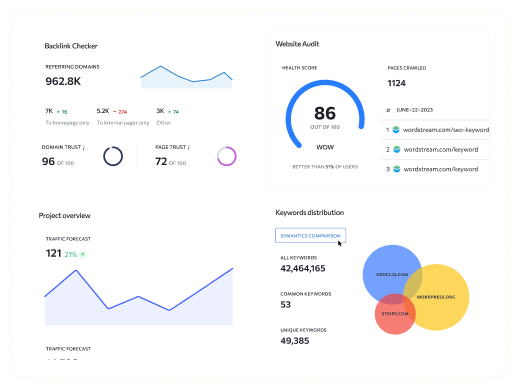Looking to boost your ecommerce website’s organic traffic and sales? This ecommerce SEO case study provides actionable insights and proven strategies to help you achieve significant SEO results. By examining the journey of a mid-sized ecommerce brand, we’ll uncover the tactics that led to a remarkable increase in traffic and revenue.
Search engine optimization (SEO) is crucial for ecommerce businesses to thrive in a competitive digital landscape. In this post, we’ll delve into a comprehensive ecommerce SEO case study, revealing how a strategic approach can overcome common challenges and drive substantial growth. Whether you’re new to SEO or seeking advanced strategies, this case study offers valuable takeaways. Discover how fixing common mistakes and implementing effective strategies can transform your ecommerce site.
About the Ecommerce Brand
Brand Overview
Our subject in this SEO ecommerce case study is a well-established purveyor of high-quality herbs and spices. Founded in 2004, the brand expanded across 15 states and served over 1,500 restaurants, boasting more than 30 physical retail stores. Despite its esteemed reputation, the brand struggled with maintaining a strong online presence and faced stiff competition from smaller, digitally-savvy brands.
This scenario is common in many ecommerce SEO case studies, where traditional businesses find it challenging to adapt to the digital market.
Initial Challenges
Several SEO challenges hindered the brand’s online performance:
- Outdated On-Page SEO Practices: The brand’s website lacked modern on-page SEO tactics, which are crucial for search engine visibility.
- Neglected Backlinks: Backlinks are essential for SEO success, but the brand had completely neglected this aspect.
- Reluctance to Invest in SEO: Due to previous poor results, the brand was hesitant to allocate more resources to SEO.
- Slow Page Load Speed: The website had significant issues with loading times, which deterred visitors and affected the user experience.
- Poor Mobile Usability: With a growing number of users accessing websites via mobile devices, the lack of mobile optimization was a major drawback.
SEO Analysis and Initial Findings
Website Audit
A thorough audit of the brand’s website revealed multiple issues affecting its SEO performance. Key problems included outdated SEO strategies, lack of backlinks, slow loading times, and poor mobile usability. This step is critical in any SEO case study ecommerce project as it lays the foundation for the strategy.
Common SEO Issues
- Outdated On-Page SEO: The site did not follow current best practices for on-page optimization, such as using relevant meta tags, headers, and image alt texts.
- Neglected Backlinks: Backlinks, which are crucial for SEO success, were completely overlooked, resulting in low domain authority.
- Reluctance to Invest in SEO: The brand had previously experienced poor results from SEO efforts and was hesitant to invest further.
- Slow Page Load Speed: The large website had significant issues with loading times, which deterred visitors and impacted search rankings.
- Poor Mobile Usability: The website was not optimized for mobile devices, leading to a poor user experience and lower rankings on mobile search results.
Developing an SEO Strategy
Setting Goals and KPIs: We set clear, measurable goals and key performance indicators (KPIs) for the SEO campaign, focusing on increasing organic traffic, improving keyword rankings, and boosting revenue. Specific goals included a 50% increase in organic traffic within six months, a 20% improvement in keyword rankings, and a 30% increase in online sales.
Keyword Research and Mapping: A comprehensive keyword research process was implemented to identify the most valuable keywords. This involved analyzing competitor keywords and using tools like Ahrefs and Google Keyword Planner to create a detailed keyword map. The keyword mapping process involved categorizing keywords into different buckets based on relevance and search volume, ensuring a targeted approach for each page of the website.
On-Site SEO Tactics
- Improving UX and Mobile Usability: Enhancing user experience (UX) and ensuring the site was mobile-friendly were top priorities. This included redesigning the navigation, improving page layouts, and making the site responsive across all devices.
- Site Speed Optimization: Addressing issues that slowed down page load times, such as optimizing images, enabling browser caching, and minimizing JavaScript and CSS files.
- Content Optimization: Creating high-quality, keyword-optimized content that provides value to users and meets search intent. This included updating existing content and creating new blog posts, product descriptions, and landing pages.
- Structured Data and Schema Markups: Implementing structured data to enhance search engine visibility and enable rich snippets in search results. This included adding schema markup for products, reviews, and FAQs.
Implementing the SEO Strategy
Technical SEO Improvements
- Compressing Images: Optimizing image file sizes to improve load times and reduce bandwidth usage. This involved compressing high-resolution images and using appropriate formats like JPEG and PNG.
- Enhancing Site Structure: Making URL tweaks and fixing broken links to improve site navigation and user experience. This included implementing a clear and logical URL structure, creating an XML sitemap, and setting up proper redirects.
- Schema Markup Integration: Adding schema markup to enable rich snippets in search results, enhancing the visibility of products, reviews, and other key elements. This helped improve click-through rates and provided users with more information directly in the search results.
Content Strategy
- High-Quality Content Creation: Developing engaging and informative content using target keywords. This included writing in-depth blog posts, how-to guides, and detailed product descriptions that address customer pain points and provide solutions.
- Contextual Internal Linking: Building a strong internal linking structure to improve site navigation and SEO. This involved linking relevant pages together to create a cohesive user journey and distribute link equity throughout the site.
- Launching New Content Silos: Organizing content into silos to enhance topical relevance and improve search rankings. This included creating dedicated sections for specific topics and interlinking related content.
Mobile Optimization
- Mobile Usability Audit: Identifying and fixing mobile usability issues to enhance the user experience on mobile devices. This involved conducting a thorough audit using tools like Google’s Mobile-Friendly Test and fixing issues such as text size, tap targets, and viewport configuration.
- Implementing AMP (Accelerated Mobile Pages): Enhancing mobile page performance by implementing AMP, which ensures faster loading times and a better user experience on mobile devices.
Off-Page SEO and Link Building
- Building High-Quality Backlinks: We focused on acquiring high-quality backlinks from authoritative sites, using strategies like guest posting and digital PR. This involved reaching out to relevant websites, creating valuable content, and earning backlinks that improve domain authority and search rankings.
- Digital PR and Guest Posting: Engaging in digital PR efforts and guest posting on relevant sites helped build a strong backlink profile and improve domain authority. This included writing guest posts for industry blogs, participating in online forums, and submitting press releases to high-authority news sites.
Results and Success Metrics
- Traffic and Ranking Improvements: The SEO campaign led to a substantial increase in organic traffic and improved keyword rankings. Within the first six months, the website’s organic traffic increased by 50%, and the brand started ranking on the first page of Google for several high-value keywords.
- Revenue Growth: The brand saw significant revenue growth, with organic traffic directly contributing to increased sales. Online sales grew by 30%, and the overall conversion rate improved due to better user experience and targeted content.
- Key Performance Metrics: The campaign’s success was evident in the substantial improvements in traffic, rankings, and revenue. Key performance metrics included a higher domain authority, increased number of backlinks, improved page load speeds, and enhanced mobile usability.
Challenges and How They Were Overcome
- Initial Traffic Plateau: The brand experienced a traffic plateau, which was overcome by experimenting with new SEO tactics and continually optimizing content. This included updating old content, launching new content silos, and improving internal linking to boost topical relevance.
- Adapting to Google Algorithm Updates: The SEO strategy was regularly adjusted in response to Google algorithm updates to maintain and improve search rankings. This involved staying up-to-date with the latest SEO best practices, monitoring algorithm changes, and making necessary adjustments to the strategy.
Conclusion
This ecommerce SEO case study demonstrates the importance of a comprehensive and strategic approach to SEO. Key takeaways include the significance of technical SEO, high-quality content, mobile optimization, and a strong backlink profile. By addressing common SEO issues and implementing a well-rounded strategy, ecommerce businesses can achieve significant improvements in traffic, rankings, and revenue.
Note: Read Our Latest Marketing and SEO Blogs:
Seo for startups | Ai copywriting tools | Ai logo generators | E commerce Inventory Management | Saas ppc strategies | What is ai blogging | AI Powered SEO | What is wix analytics | What is b2c seo | Ai seo content generator.
Frequently Asked Questions
Q1. What is an ecommerce SEO case study?
A1: An ecommerce SEO case study is a detailed analysis of SEO strategies applied to an ecommerce website, highlighting the processes, challenges, and results of these efforts. It provides insights and actionable tactics that can help other ecommerce businesses improve their SEO performance.
Q2. Why is keyword research important in SEO for ecommerce?
A2: Keyword research is crucial because it helps identify the search terms potential customers use. By targeting these keywords, you can optimize your content to match search intent, improve your search engine rankings, and attract more organic traffic to your ecommerce site.
Q3. How do backlinks influence SEO performance?
A3: Backlinks from authoritative sites signal to search engines that your content is valuable and trustworthy. They help increase your domain authority, improve your site’s visibility in search results, and drive referral traffic.
Q4. What are the benefits of optimizing for mobile usability?
A4: Optimizing for mobile usability ensures that your website provides a seamless experience for users on smartphones and tablets. This improves user engagement, reduces bounce rates, and can positively impact your search engine rankings, as search engines prioritize mobile-friendly sites.
Q5. How often should you update your SEO strategy?
A5: You should regularly update your SEO strategy to adapt to changes in search engine algorithms, industry trends, and user behavior. Continuous optimization and staying informed about SEO best practices are essential for maintaining and improving your website’s performance in search results.





